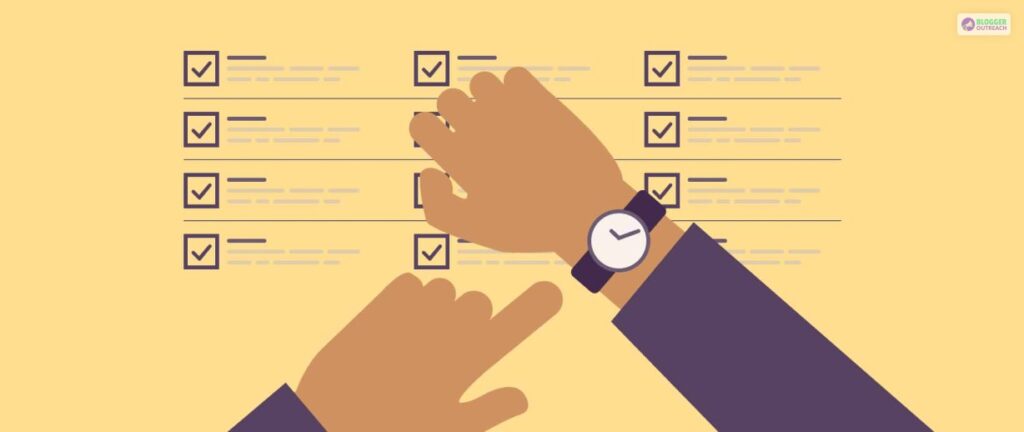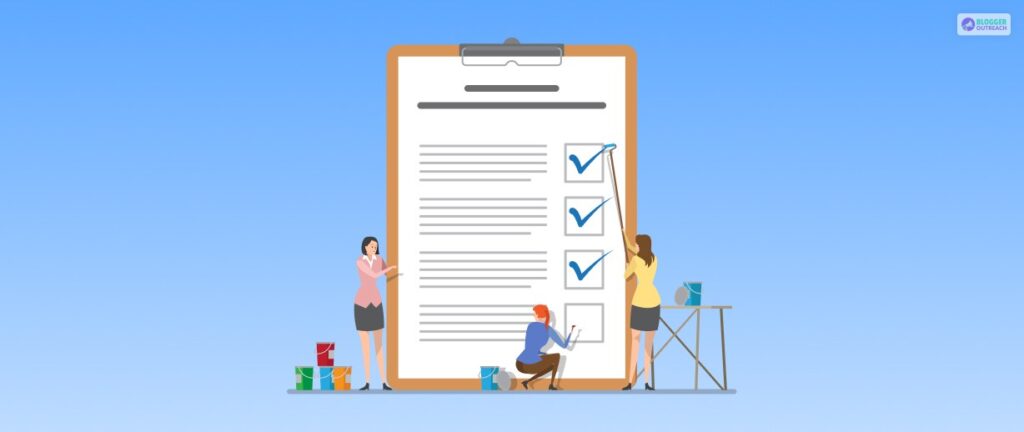Table Of Content
- 1 The Significance Of Checklist
- 2 10 Tips To Write A Checklist
- 2.1 1. Define Your Goals
- 2.2 2. Extensive Research
- 2.3 3. Create A Title That Resonates With The Goal
- 2.4 4. Crisp And Effective Description
- 2.5 5. Keep The Format Consistent
- 2.6 6. Break Down Your Tasks
- 2.7 7. Prioritize Your Checklist
- 2.8 8. Focus On Relevant Questions
- 2.9 9. Write Sub-Points
- 2.10 10. Do Not Rush
- 3 The Final Takeaway!
Struggling with an excessive workload?
Need to make sure you don’t miss a step in your project workflow?
Checklists can help you stay on track and make sure you’re ticking off all the right boxes.
They’ll not only help you organize tasks but also make sure you don’t miss anything important. Create checklists and increase efficiency!
Checklists are essential for tackling a project thoroughly and completely. They guarantee that there is process collaboration between individuals who may take part in finishing them and, most importantly, that nothing is overlooked while in transit.
No more repeating the same tedious tasks or worrying about forgetting something along the way. Create a checklist and get more organized!
Do you want to learn how to make the most of checklists and reminders? We’ve got you covered with our tips to help make your next checklist better than ever.
Follow these steps, and you’ll be set to save time and cut down on mistakes.
The Significance Of Checklist

Need to remember what needs to get done? Checklists can help!
- They create ownership, deadlines, and expectations and free up your mind so you can confidently delegate tasks.
- A checklist ensures that you always have a sense of direction to stay focused on the important tasks. As a result, checklists can help you stay organized, save time, and reduce stress.
- You can leverage a checklist for various tasks, from vacation planning to completing work projects. Checklists help you remember important details that you might otherwise forget.
- They can ensure that everyone is on the same page and the completion of all tasks. Checklists can also help you track progress and stay on schedule.
- Checklists can also help you stay motivated. Breaking down a task into smaller steps makes it easier to stay focused and motivated.
10 Tips To Write A Checklist
Now that you have an idea regarding what a checklist is, let’s dig into the core essentials of writing a checklist.
1. Define Your Goals

Before you start writing, it’s important to define your goals for the checklist. Doing so will help you create a checklist tailored to your needs and help you achieve the desired outcome.
(i) What You Want To Accomplish
The first step in defining your goals is to identify what you want to accomplish with the checklist.
For example, are you creating a checklist to help you remember tasks for a specific project?
Are you creating a checklist to help you stay organized?
Or are you creating a checklist to help you remember tasks for a particular event?
Once you’ve identified the purpose of the checklist, you can begin to create a list of tasks you will accomplish.
(ii) Scope
Next, you’ll want to consider the scope of the checklist.
For example, are you creating a checklist that covers a single task or event, or are you creating a checklist that covers multiple tasks or events?
If you’re making a checklist that covers multiple tasks or events, you’ll need to consider prioritizing the tasks and breaking them down into manageable chunks.
(iii) Format
Finally, you’ll want to consider the format of the checklist. For example, are you creating a printable checklist, or are you creating a digital checklist? If you’re creating a digital checklist, you’ll need to consider how you’ll store the checklist and how you’ll access it.
2. Extensive Research

Researching will help you ensure that you include all the necessary items and get all the important information.
(i) Research The Topic
Once you have identified the purpose of the checklist, it is time to start researching the topic. Start by searching online for relevant information, reading books or articles related to the topic, or talking to experts in the field. Again, it is important to ensure you get accurate and up-to-date information.
(ii) Gather The Information
After you have done your research, it is time to start gathering the information. Write down the information you have found or create a spreadsheet or database to store the information. It is important to ensure you include all the necessary information in your checklist.
(iii) Organize The Information
First, create categories or sections for the different items in the checklist. This will help you ensure that you include all the necessary things and that you get all the important information.
3. Create A Title That Resonates With The Goal

Once you’re clear about the goal of your checklist, it’s important to create a title that is in line with the purpose of the checklist.
(i) Use Keywords
Keywords are words that are associated with the goal of the checklist. For example, if the goal is to help people save money, you might use words like “budget“, “savings“, or “frugal“. Using keywords in the title will help readers quickly identify the purpose of the checklist.
(ii) Make It Catchy
Once you have the goal and keywords in mind, you can start to craft a catchy title. Again, try to make it as short and snappy as possible while still conveying the goal of the checklist.
(iii) Test It Out
Once you have a title, it’s a good idea to test it out on a few people to see if it resonates with them. Ask them if the title accurately reflects the goal of the checklist and if it’s catchy enough to draw them in.
4. Crisp And Effective Description

When writing descriptions for your checklist, it’s important to start with the basics. Ensure that you include the task’s name, the completion date, and any other relevant information.
(i) Be Specific
When writing descriptions for your checklist, it’s important to be as specific as possible. This will help ensure that you don’t forget any important details and that you can complete the task in the most efficient way possible.
(ii) Use Action Words
When writing descriptions for your checklist, it’s important to use action words. This will help ensure you can complete the task as efficiently as possible. For example, you could write “complete the report” instead of writing “write the report“.
(iii) Check For Accuracy
Finally, checking for accuracy when writing descriptions for your checklist is important. Ensure that you have included all the necessary information and that the descriptions are clear and concise. This will help ensure that you can complete the task the most efficiently as possible.
5. Keep The Format Consistent

Whether you’re creating a checklist for yourself or a team, it’s important to keep the formatting consistent.
(i) Choose A Font And Font Size
Choosing a font that is easy to read and understand is best. Arial, Calibri, and Times New Roman are all good choices. The font size should be large enough to be easily read but not so large that it takes up too much space.
(ii) Use A Consistent Layout
This means that all the items on your checklist should be in the same format. For example, if you’re using bullet points, ensure that everything is in the same style. You can also use checkboxes or numbers to indicate completed tasks.
(iii) Use Colors To Differentiate Between Tasks
Use distinct colors to differentiate between completed tasks and tasks that are still pending. For example, you can use green to indicate that a task is completed and red to indicate that it is still pending.
(iv) Use A Consistent Structure
For example, you can organize tasks by category, priority, or due date. This will make it easier to find the tasks you need to complete.
(v) Use A Consistent Format For Dates
Keep the formatting intact throughout your checklist. For example, you can use the month/day/year format or the day/month/year format.
6. Break Down Your Tasks

The foundation of any successful task management strategy is a structured method that makes sure nothing is missed. Make a thorough list of everything that needs to get done, including chores for the house, work, and personal development. This first step gives you a clear picture of your tasks.
Next, group these tasks according to their purpose or type. Sorting them into sections like “Work Tasks,” “Home Tasks,” and “Personal Development” facilitates efficient time management and priority setting.
After classifying, divide every task into manageable, smaller segments. This subdivision makes difficult tasks more manageable and allows you to stay focused on one step at a time, boosting productivity.
Setting priorities is essential to efficient work management. Analyze each assignment in its respective category, considering importance and urgency. Prioritizing tasks in order of priority guarantees that crucial deadlines and significant goals are achieved.
Making thorough checklists for each task guarantees that nothing gets missed. These checklists act as road maps, directing activity and offering a sense of satisfaction upon job completion.
Last but not least, give each assignment or subtask a reasonable deadline. Set deadlines to maintain momentum, instill a feeling of urgency, and facilitate effective time management.
You will boost your overall efficiency in reaching your goals, preserve organization, and expedite work management by adhering to these systematic methods.
7. Prioritize Your Checklist

Do you have too many tasks and need more time? Prioritizing your checklist can help you make the most of your time and get the most important tasks done first.
Certain tasks are more important than others; not all tasks are made equal. Assigning jobs a priority according to their significance and urgency guarantees that crucial tasks are not overlooked. The Eisenhower Matrix is a useful tool for this.
- Important and Urgent: These chores must be completed right now. For instance, it is imperative to fulfill an urgent request from a significant client right away.
- Important But Not Urgent: Plan these chores until later if they are important but not urgent. For example, creating a long-term marketing plan is necessary for success but doesn’t need to be done right now.
- Urgent But Not Important: Delegate these duties, if you can. One instance is responding to standard emails that need to be answered right away but are not essential to achieving your primary goals.
- Neither Important Nor Urgent: Reject these tasks. For instance, wasting time on pointless surfing is distracting and does not progress your goals.
Using the Eisenhower Matrix allows you to focus your attention on what is most important, increasing productivity and ensuring key tasks are accomplished effectively.
8. Focus On Relevant Questions

Don’t be afraid to ask questions – but make sure they count!
Prioritize the questions that address the core objective of getting the most useful information.
Ask the right questions and get the data you need to make better decisions.
(i) Brainstorm Questions
Once the purpose of the checklist has been identified, it is time to brainstorm questions that are relevant to the purpose of the checklist. This can be done by considering the steps that need to be taken to complete the task and the potential problems that could arise.
(ii) Prioritize Questions
After brainstorming questions, it is important to prioritize the questions. This will help to ensure that the most important questions are included in the checklist.
9. Write Sub-Points

Before you start writing sub-points, it’s important to identify the main point of your checklist.
This will help you create a structure and ensure that all of your sub-points are related to the main point.
(i) Break Down The Main Point
Once you have identified the main point of your checklist, you can start breaking it down into smaller, more manageable sub-points. This will help you create a more organized checklist and make it easier to complete each task.
When writing your sub-points, it’s important to prioritize the most important tasks first. This will help you stay focused and ensure that you complete the most important tasks first.
(ii) Be Specific
When writing your sub-points, make sure to be as specific as possible. This will help you stay on track and make sure that you don’t forget any important details.
10. Do Not Rush

Managing multiple responsibilities in our busy lives frequently tempts us to multitask, which results in incomplete work. Completing one job at a time is your top priority while making a checklist.
First, make a list of your chores and work your way through them. Even with a tough job, this strategy guarantees a calmer mood and helps retain focus.
It’s important to take breaks between tasks. They help you stay focused and increase productivity. Taking a few minutes to de-stress and gather your thoughts is really helpful.
Adhering to this planned process can help you efficiently manage your workload, finish activities quickly, and maintain a balanced attitude to productivity.
The Final Takeaway!
Before we wrap up this article, let’s give you additional insights into different methods of checklists.
The most common type of checklist is the basic to-do list. This is a simple list of tasks that need to be completed, with a checkbox beside each item.
Another type of checklist is the process checklist. This type of checklist is used to ensure that all steps of a process are completed in the correct order.
The third type of checklist is the safety checklist. This type of checklist is used to ensure that safety protocols are followed in a particular environment.
Finally, there is the audit checklist. This type of checklist is used to ensure that all aspects of an audit are completed correctly.
Writing a checklist is but it is important to make sure that all items are checked off before moving on to the next task.
Hope you get great value! For further assistance regarding this topic or any other topic, feel free to reach out.
Read Also:








